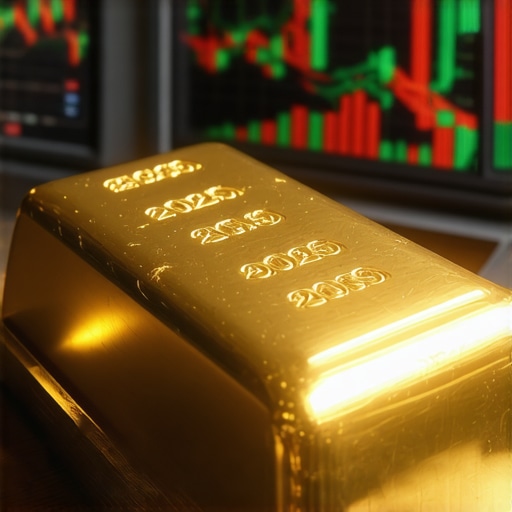How I Learned to Read the Gold Market’s Pulse in 2025
I still remember the first time I noticed how unpredictable gold prices could be. It was early 2025, and I had just started paying close attention to the gold market after hearing about some major price swings. As someone who dabbles in gold investments, I quickly realized understanding what drives those fluctuations isn’t just about glancing at charts—it’s about piecing together a complex puzzle of global events, economic indicators, and investor behavior.
Why Gold Prices Dance: My Take on the Key Drivers
Over the months, I noticed certain factors kept popping up as main influencers. Inflation, for one, plays a huge role. When inflation rises, gold often gains appeal as a hedge against the declining value of currency. But it’s not just inflation; geopolitical tensions, like conflicts or trade disputes, tend to push gold prices higher as investors seek safety. Central bank activities also caught my eye—when major banks increase their gold reserves, it signals strong demand that can sway prices significantly.
Another intriguing driver I explored was market sentiment and speculative trading. Gold futures and exchange-traded funds (ETFs) introduce volatility that can sometimes seem disconnected from physical demand. This made me dive deeper into trading techniques and market analysis to better navigate these fluctuations. If you’re curious, I found a helpful guide on mastering gold trading techniques for 2025 that really sharpened my approach.
Have you wondered how global economic policies shape gold’s price trajectory?
For me, understanding the influence of monetary policies was a game changer. Interest rate decisions by central banks, for example, often directly affect gold’s attractiveness. Lower rates reduce the opportunity cost of holding non-yielding assets like gold, boosting demand and price. Conversely, rising rates might cool enthusiasm temporarily. The interplay between these policies and gold is a fascinating dance that requires constant attention.
Reading reports from institutions like the World Gold Council helped me stay informed on these trends. Their detailed market analysis offers valuable insights into supply and demand dynamics, which are crucial for anyone invested in gold. If you want to deepen your understanding, their resources are a solid starting point.
How I Use This Knowledge to Make Smarter Investment Choices
Armed with these insights, I’ve become more confident in timing my gold investments and choosing the right vehicles—whether physical bullion, ETFs, or futures contracts. Each option reacts differently to market drivers, so tailoring my strategy has helped me avoid common pitfalls. For example, learning how to safely buy and store gold coins gave me peace of mind and flexibility in my portfolio.
One resource I found particularly useful is a step-by-step guide on buying gold bullion safely, which walks through crucial considerations and trustworthy dealers. Exploring different types of gold investments also helped me balance my approach and maximize growth potential.
If you’re navigating the gold market in 2025, I’d love to hear about your experiences or questions. Feel free to share your thoughts in the comments or check out some of the detailed analyses and guides I’ve linked here to help you build a resilient gold portfolio.
Decoding the Role of Central Banks in 2025 Gold Price Movements
Central banks have become pivotal players in the gold market’s intricate dance, particularly in 2025. Their buying and selling patterns not only reflect economic strategies but also send strong signals to investors globally. When a central bank increases its gold reserves, it often indicates a hedge against currency risk or geopolitical uncertainties, which in turn can lead to upward pressure on gold prices. Conversely, selling gold reserves might suggest confidence in economic stability or liquidity needs, sometimes causing price dips.
Understanding these institutional moves requires keen attention to official reports and market commentary. For example, the analysis on central bank gold purchases reveals how shifts in reserve management strategies impact global gold demand and prices. As an investor, incorporating this knowledge helps in forecasting potential price surges or declines with better accuracy.
Integrating Gold Futures and ETFs into a Balanced Portfolio
With a grasp on gold’s fundamental drivers, leveraging financial instruments like gold futures and ETFs can optimize portfolio performance. Futures contracts offer exposure to gold price movements without physical ownership, appealing for short to medium-term strategies. Meanwhile, ETFs provide liquidity and diversification benefits, making them suitable for long-term holdings.
However, each instrument carries distinct risks and benefits. Futures involve leverage and require a strong understanding of market timing, while ETFs might be influenced by management fees and tracking errors. For those seeking guidance, exploring detailed resources on comparing gold ETFs and stocks is invaluable for crafting a strategy aligned with one’s risk tolerance and investment horizon.
How Can Investors Effectively Navigate Gold Market Volatility in 2025?
Volatility is a defining feature of the gold market, driven by rapid geopolitical developments, fluctuating monetary policies, and speculative trading. So, how can investors safeguard and grow their portfolios amid these shifts? One approach is to employ proven gold trading techniques that emphasize risk management, such as setting stop-loss orders and diversifying gold holdings across physical and paper assets.
Additionally, staying informed through reputable sources like the World Gold Council helps investors anticipate market movements by analyzing supply-demand trends and macroeconomic indicators. According to the World Gold Council’s 2025 market outlook, gold’s role as a hedge against inflation and currency depreciation remains robust, but investors must be nimble to adjust strategies in response to unexpected events.[1]
Combining fundamental analysis with disciplined trading practices enhances resilience against volatility. For newcomers, gradually building exposure through diversified instruments and secure physical gold purchases, guided by expert advice, can mitigate risks while positioning for long-term gains.
If you’re actively investing or considering entering the gold market, I invite you to share your questions or experiences below. Also, explore my detailed guides and analyses linked throughout this post to deepen your understanding and refine your investment approach for 2025 and beyond.
Reflecting on the Emotional Side of Gold Investing
One aspect that often escapes purely analytical discussions about gold investing is the emotional rollercoaster it can trigger. I’ve found that beyond charts and economic data, my own feelings sometimes sway my decisions more than I’d like to admit. During volatile periods, it’s tempting to let fear or greed take control, but experience has taught me that cultivating patience and discipline is indispensable. Balancing rational analysis with emotional awareness has made my investment journey more sustainable and less stressful.
How Do I Manage Emotional Biases When Trading Gold?
For me, a practical way to curb impulsive moves has been setting predefined entry and exit points based on thorough research. This approach minimizes knee-jerk reactions to sudden price swings. Additionally, diversifying across different types of gold investments—from physical bullion to ETFs and futures—helps distribute risk and reduce anxiety tied to any single asset class. I also regularly revisit trusted resources like the World Gold Council’s detailed market research (1) to ground my decisions in facts rather than speculation.
Understanding that gold’s allure partly lies in its symbolic value and historical role as a financial safe haven adds another layer to how I perceive market movements. This awareness helps me appreciate why emotions run high during geopolitical tensions or inflation spikes, and it reminds me to stay grounded in fundamentals.
Advanced Strategies: Timing and Diversification in a Complex Market
Over time, I’ve realized that timing the gold market perfectly is nearly impossible, which is why I focus on strategic diversification and gradual accumulation. For example, combining physical gold investments like coins or bars with financial instruments such as ETFs or futures contracts allows me to react flexibly to shifting market conditions. If you’re interested, exploring guides on gold futures trading basics and top gold ETFs can offer valuable perspectives on blending these approaches.
Another subtlety I’ve encountered is the impact of macroeconomic narratives on gold’s momentum. For example, when central banks signal prolonged low interest rates or hint at quantitative easing, gold often gains traction as a hedge. Conversely, tightening cycles can temporarily dampen enthusiasm. Staying alert to these narratives requires not just watching the numbers but interpreting the underlying policy intentions.
How Do Global Economic Shifts Influence Gold Demand Beyond the Obvious?
Digging deeper, I’ve noticed that emerging market dynamics also play a critical, sometimes overlooked, role in shaping gold demand. Countries like India and China, with their cultural affinity for gold, can sway prices significantly through consumer buying patterns. Additionally, shifts in technology—for instance, advances in gold recycling or new industrial applications—can subtly affect supply-demand balances.
These nuanced factors remind me that the gold market is not static; it evolves with societal and economic transformations. Staying ahead means continuously expanding my understanding through diverse sources and being open to new interpretations.
If you’ve encountered similar complexities or have questions about blending emotional discipline with technical strategies in gold investing, please share your thoughts below. Engaging with a community of informed investors has enriched my perspective and might do the same for you.
Balancing Emotional Discipline with Market Complexity for Sustainable Gold Investing
Reflecting on my journey through the gold market in 2025, I’ve come to appreciate that mastering the emotional nuances is as critical as understanding the economic fundamentals. The gold market, with its inherent volatility driven by geopolitical uncertainties and shifting monetary policies, often tests an investor’s psychological resilience. My personal experience taught me that nurturing emotional discipline—recognizing when anxiety or exuberance clouds judgment—is essential for making informed decisions rather than reactive ones. This balance has allowed me to maintain composure during turbulent times and capitalize on strategic opportunities.
One technique I’ve found invaluable is maintaining a trading journal where I record not only my technical reasoning but also my emotional state at each decision point. This practice has deepened my self-awareness and helped me identify patterns in my behavior that might otherwise lead to impulsive trades. If you want to refine your approach, exploring proven gold trading techniques can provide tactical frameworks to manage both market fluctuations and emotional responses.
Deciphering the Impact of Emerging Technologies on Gold Demand and Market Structure
Beyond traditional drivers, I’ve been intrigued by how emerging technologies are subtly reshaping gold’s demand landscape. Innovations such as blockchain-based gold tokenization are beginning to transform how investors access and trade gold, increasing liquidity and democratizing participation in markets previously dominated by institutional players. Additionally, advancements in gold recycling technologies and expanding industrial applications in electronics and medicine are influencing supply-demand dynamics in nuanced ways.
Staying abreast of these developments requires continuous learning and engagement with industry reports and expert analyses. For instance, the World Gold Council’s latest insights highlight how technological integration is enhancing transparency and efficiency in gold markets, thereby affecting price behaviors and investor strategies[1]. Incorporating these perspectives into my investment framework has expanded my understanding of gold’s evolving role beyond a mere safe haven.
What Advanced Techniques Can Experienced Investors Use to Anticipate Gold Market Turning Points?
Addressing this question from my own practice, I emphasize the integration of multi-dimensional analysis—combining technical indicators, macroeconomic narratives, and real-time geopolitical intelligence. For example, monitoring central bank gold purchase patterns alongside shifts in global monetary policy announcements can yield predictive insights about imminent price movements. I also leverage sentiment analysis tools that scan news flows and social media trends, offering early signals of market mood shifts.
Engaging with comprehensive resources like in-depth gold market analyses helps refine these techniques, supporting a proactive rather than reactive investment stance. Personally, this approach has enhanced my ability to identify entry and exit points that align with both short-term volatility and long-term trends.
If you’re ready to elevate your gold investing strategy with these advanced insights and personal experiences, I encourage you to dive deeper into the linked guides and share your own strategies or questions below. Engaging in thoughtful dialogue enriches our collective understanding and sharpens our market acumen for 2025 and beyond.
Things I Wish I Knew Earlier (or You Might Find Surprising)
The Emotional Rollercoaster Is Real—and Manageable
When I first dove into gold investing, I underestimated just how much my emotions would influence my decisions. The swings in price can trigger fear or excitement that clouds judgment. What helped me most was realizing this wasn’t unique to me and developing routines—like keeping a trading journal—to track both my market analysis and emotional state. It’s a small step that made a big difference in staying disciplined.
Not All Gold Investments React the Same Way
I used to think gold was gold—no matter how you invested. But physical bullion, coins, ETFs, and futures each respond differently to market shifts. Understanding these nuances helped me tailor my portfolio to balance liquidity, risk, and long-term growth. If you want a solid starting point, exploring different types of gold investments can clarify which fits your goals best.
Central Banks Are Silent Influencers
Early on, I overlooked how central bank gold purchases and sales shape global demand and prices. Their moves are like whispers in the market, signaling shifts in economic confidence or geopolitical risk. Paying attention to official reports and analyses gave me an edge in anticipating price movements.
Technological Changes Are Quietly Reshaping the Market
I hadn’t realized how innovations like blockchain tokenization and advanced recycling affect gold’s accessibility and supply. These emerging trends are changing who can invest and how gold circulates in the market. Staying informed here helps me appreciate gold’s evolving role beyond just a safe haven.
Timing the Market Perfectly Is a Myth
Trying to time every price swing only led to frustration. Instead, I found that gradual accumulation combined with diversification across physical and paper gold reduces stress and improves long-term results. It’s about playing the long game with smart strategies rather than chasing quick wins.
Resources I’ve Come to Trust Over Time
World Gold Council: Their in-depth market research and demand trend reports have been invaluable in understanding the bigger picture and staying updated on global shifts. I often recommend their insights to friends seeking a solid foundation.
BuyingGoldNow.com: This site offers practical guides on everything from buying gold bullion safely to mastering trading techniques and comparing gold ETFs versus stocks. Their step-by-step approaches are clear and trustworthy, perfect for both beginners and experienced investors.
Central Bank Gold Purchase Analyses: Detailed breakdowns on how central banks influence gold demand helped me anticipate market moves more confidently. Understanding these institutional dynamics adds a strategic layer to my investing.
Gold Futures Trading Guides: Learning the basics and advanced tactics of futures trading through reliable tutorials helped me navigate volatility with greater control and discipline.
Sentiment and Technical Analysis Tools: Integrating market sentiment indicators and real-time geopolitical news sources enhanced my ability to read market moods, which is crucial in such a reactive market.
Parting Thoughts from My Perspective
Reflecting on my journey through the gold market in 2025, I realize that successful gold investing blends both knowledge and emotional discipline. Understanding the key drivers behind gold prices, from inflation to central bank activity and emerging tech, equips you with a solid framework. But equally important is managing your own reactions to market volatility and staying patient with your strategy.
Gold remains a fascinating and valuable asset in an ever-changing economic landscape. If this resonated with you, I’d love to hear your thoughts or experiences. Feel free to share your insights or questions in the comments. Let’s keep the conversation going and help each other navigate the exciting world of gold investing in 2025 and beyond.










Reading through the post, I am struck by how central the role of central banks is in influencing gold prices—especially in 2025 where their strategic reserves seem to be more dynamic than ever. What I found particularly interesting is the connection between their reserve management and market sentiment; it’s almost like their actions echo the broader economic confidence or uncertainty. I’ve been tracking their purchases more closely and noticed that during periods of geopolitical tension or economic stabilization, their moves tend to predict short-term price shifts.
In my experience, combining this with technical analysis, such as monitoring gold ETF inflows and outflows, offers a more comprehensive picture. For example, during recent quarters, increased central bank buying coincided with rising ETF investments, which reinforced my confidence in the market’s upward momentum.
How do others here integrate central bank activity with technical signals or macroeconomic trends? Are there particular indicators or reports you’ve found especially reliable in anticipating these institutional moves?